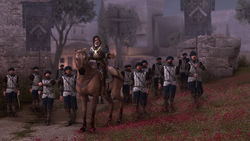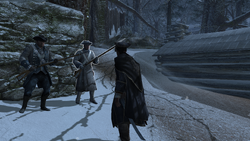
|
Where are the paintings? This article is in need of more images and/or better quality pictures from official media in order to achieve a higher status. You can help the Assassin's Creed Wiki by uploading better images on this page. |
The French Army is the land-based, and largest, component of the French Armed Forces. Throughout history, they have regularly fought the British Army for power and influence, as part of the two nations’ historic rivalry, and also vied for control of Italy.
The uniforms of the French Royal Army mostly varied in color depending on the rank and unit type of soldier. Colors ranged from purple to red, blue and green. However, French soldiers stationed in New World Colonies during the late 17th century and into the 18th century were known as the Troupes de la Marine and were a large regiment of soldiers who wore white uniforms, usually with blue coat tails, blue sleeves and black tricorne hats.
History
Renaissance
In 1499, King Louis XII forged a secret alliance with Cesare Borgia, son of Pope Alexander VI, through Cesare's relationship with Louis' distant cousin, Baron Octavian de Valois. Cesare, the de facto leader of the Templar Order, planned to conquer Italy, and King Louis XII sent an army of soldiers led by Octavian to aid Cesare.[1]

Octavian de Valois and his French forces
The French Army set up their headquarters in the Castra Praetoria, in Rome, and remained in the city for the next three years to protect the Vatican from the Assassins. They stormed Monteriggioni with the Papal army under Cesare and Octavian's command. The French forces quickly became entangled with the local mercenary guild led by the Assassin condottiero Bartolomeo d'Alviano.[1]
In August 1503, the Master Assassin Ezio Auditore da Firenze aided the mercenaries in removing the French presence in Rome, after Octavian kidnapped Bartolomeo's wife, Pantasilea Baglioni. Taking on the guise of French soldiers, Ezio and a regiment of mercenaries infiltrated the Castra Praetoria pretending to deliver Bartolomeo to Octavian, in exchange for Pantasilea's freedom. When Octavian instead opted to kill Pantasilea, the mercenaries attacked and a skirmish ensued inside the fortress. Octavian retreated deeper into the fortress with his hostage, though Ezio managed to pursue and assassinate him. Following Octavian’s death, the remaining French forces retreated back to France.[1]
In 1509, the French were at war with the Republic of Venice. Despite Bartolomeo's efforts, the French were victorious at the Battle of Agnadello, causing the Assassins stationed there to lose possession of the Shroud of Eden. Four years later, France and Venice united against Milan, and Bartolomeo served under French command.[2]
Colonial era
After the Age of Discovery, France joined many of its European neighbors, including its historical rival, Great Britain, in the race to colonize the New World; France soon founded colonies in a variety of regions, such modern-day Canada, the future United States, and also Saint-Domingue, in the Caribbean. The French Army was present in all of these colonies, enforcing the French regime.[3]

Haytham Kenway standing by a pair of French soldiers
Following the outbreak of the Seven Years' War in 1754, the French constructed Fort Duquesne, in the American North-East. Allying themselves with the Shawnee, Abenaki and Lenape natives to propagate the conflict in the region, the French led a notable pre-emptive strike against the Braddock Expedition. The French ultimately lost the war, forcing them to cede Quebec to the British, though they secretly agreed to hand over Louisiana to the Spanish Army before signing the treaty with the British. Over a decade later, French soldiers led by the Marquis de Lafayette and the French Navy helped the Continental Army win the American Revolutionary War, striking a major blow to the British Empire.[4]
French Revolution
After the French Revolution, Napoleon Bonaparte led the French Army, then known as the Grand Armée, to many victories across Europe using an Apple of Eden.[5]
Trivia
- Stephane Chapheau's father was a cook in the French colonial army.
- Although Assassin's Creed III and Assassin's Creed III: Liberation take place in the same time period, French soldiers wear different uniforms in each game.
- In Assassins Creed III, the French and Continental soldiers wore similar uniforms.
References
| |||||||||||||||||||||||||||||||
